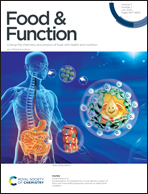Studying the effects of sea cucumber ovum powder on nonalcoholic fatty liver disease by proteomics techniques in a rat model †
Abstract
Sea cucumber is a valuable marine food that has antioxidant, anti-diabetic, and anti-obesity functionalities. Sea cucumber ovum (SCO) may contain functional components, however, it is considered to be a waste product during industrial processing. In order to make good use of SCO, this work investigated the effects of freeze-dried SCO powder on NAFLD, using a rat model, through iBT labeling proteomics techniques, tracking changes in the hepatic protein profiles of rats whose diets were supplemented with SCO powder. Male rats were fed with standard food, a high fat diet (HFD), or a HFD supplemented with 150 mg per kg BW or 450 mg per kg BW SCO powder for 6 weeks. Compared with the HFD, low-dose SCO supplementation in the diet could significantly reduce body weight gain and liver weight. Furthermore, in total, 5922 proteins were identified, and 767 proteins were found to be significantly different proteins (p < 0.05) among all four groups. Most of the significantly different proteins were related to apoptosis and lipid metabolism. Fadd, Dci, and Aif1 have been identified as key proteins in the pathways related to apoptosis, lipid metabolism, and inflammation. The results in this study provide an overview of the SCO-induced changes in the liver proteome of NAFLD, which may help us to understand the molecular mechanism behind the effects of SCO on the alleviation of NAFLD.



 Please wait while we load your content...
Please wait while we load your content...